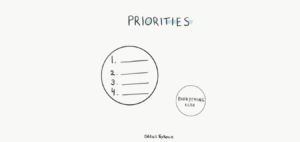
Do you act according to your habits while doing a job at your place of work, or do you think for each job and act by considering the differences? Sometimes the things we do become such a habit that we are not even aware of our actions. When we receive feedback about our behavior, we ask, “Is this what I do?” We can react. Because we are not aware. Jennifer Porter of Harvad Business Review writes about how self-awareness can evolve. Let’s listen from him:
We know that leaders need self-awareness to be effective. That is, they need an understanding of how their strengths, weaknesses, feelings, thoughts, and values affect the people around them. But that’s only half of the story. Self-awareness doesn’t work without self-management.
We will use a client of mine as an example on this topic. Let’s name him Ali. He was given repeated feedback that he spoke too often and for too long at meetings. He said he wants to improve this behavior and learn to be a more productive participant to help his team make better decisions.
After a recent meeting with 15 people, of which he spoke 30%, I asked him to evaluate his participation. “I know I talked a lot, but I had a lot to do,” she replied. Then he continued to tell me more about his ideas. Ali is very self-aware, but not as effective as he could be because he is not self-directed.
Self-management is the conscious choice to resist a preference or habit and instead engage in more productive behavior. This is a four-step process:

1) Be Prepared: Pay attention to what is happening right now. Not what was said 15 minutes ago or what will happen at your next meeting.
2) Be Aware of Yourself: What do you see, hear, feel, do and think?
3) Identify a Series of Behavioral Options: What do you want to do next? What are the possible consequences of each action? What kind of feedback did you receive that could influence your choices? What are some alternative choices you can make, even if they are not what you want to do or what you usually do?
4) Consciously Choose Behaviors that Are Believed to be Most Productive: Even if it is not the easiest behavior for you, what behavior produces the best results?
For Ali, self-management will look like this:

1) Be Prepared: “I’m focused on this conversation, really listening to everyone’s comments and paying attention to what’s going on.”
2) Be Self-Aware: “I have noticed that I am excited and eager to share my ideas. I also know that there are many people in the room who try to speak, and I know that I tend to speak very often in meetings, which can prevent others from participating.”
3) Identify a Series of Behavioral Options: “I can explain my ideas, ask a useful question, invite others to share their ideas, or listen quietly.”
4) Consciously Choose Behaviors Believed to be Most Productive: “I will hide my comments and instead listen to what others have to say. Although I really want to share my ideas, I have been told repeatedly that I talk too much and do not give others a chance to contribute. If I listen now, I will finally be giving others that chance. “
What makes self-management so difficult goes back to definition. The most productive behaviors are often not aligned with our habits and preferences. (If they were, we wouldn’t need to govern ourselves.)

Behaving in ways that are not in line with your preferences may make you uncomfortable. Working in ways that conflict with our habits can cause similar negative reactions. As a habit, our brain creates a shortcut and reacts from stimulus to response without thinking, saving both time and effort. However, unusual behavior requires us to think about a situation, evaluate choices, make a choice, and then act in accordance with that choice. This requires work. The autopilot efficiency of habits is what makes them so hard to change. It is easier and more enjoyable to give up an old habit than to spend energy on creating a new one.
Despite these obstacles, self-management is a learnable skill. You can start like this:

1) Decide where you want to be self-directed: Be mindful of how you generally work – what you say, do and do not do. Identify instances where your current approach is not working as well as you would like and self-management might be beneficial.
2) Notice and reflect on what is causing your lack of self-management: What drives your actions when you are not self-directed, but realize how you feel, what you want, and how you interpret what is going on around you? Lack of awareness, wanting to look good, lack of skills, insecurity or something else? For example, if you talk a lot in meetings, think about why you are doing it. Maybe you like your own ideas more than others, or it never occurred to you to talk less. Those of us with a bias for action may be tempted to skip this reflection step and move straight to planning and execution. But don’t! Understanding why we make the choices we make is crucial to changing those choices.
3) Consider your choices and your reaction to those choices: What else could you do if you were self-directed instead of your default behavior? What is your reaction to these options? Notice how your preferences and habits appear here, and ask yourself what you are trying to avoid when you don’t conform to those habits and preferences. When you stick to too many examples of speaking in meetings, one option you can consider is to wait for others to speak before offering your point of view. Now, consider your reaction to this option. Are you afraid that someone else will tell you your point and you won’t get praise for it, or that others won’t have as relevant ideas as yours and a bad decision will be made?
4) Make a plan: Now that you know what you want to change, have a better understanding of what drives you, and have identified some options, consider concrete steps you can take. If you talk too much, your plan may include deciding how many times and for how long to speak in a meeting, or in which meetings to just listen and speak.
5) Practice: Old habits are embedded in our brains. To change them we have to create new neural pathways (new habits), and it takes practice. If we keep too many examples of speaking in meetings, practice may seem like counting your comments and stopping when you reach your maximum. Do this over and over until you can consistently manage this behavior on your own. At the same time, discover the reactions to your app.
6) Repeat the process: Go back to step two and observe your efforts. Think over your choices, review the plan, and practice some more. With each successive iteration, you’ll learn a little more about how you work, what drives your behavior, and how you can improve it.
It’s natural to behave in ways that are good and familiar so as not to govern ourselves. But if we do this all the time, we will never be better at anything. To be as effective as possible, it is necessary to go beyond self-awareness and enter self-management. Start by recognizing your current actions and considering alternative options. Then do the hard work necessary to resist what may be most familiar or comfortable. Dedicate the most productive to implementing it effectively.














